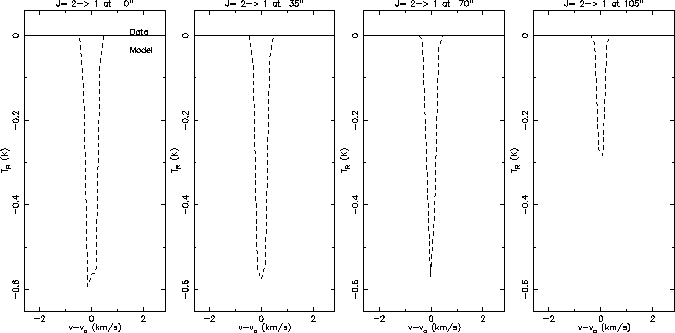




Next: The geometry routine for
Up: A Generalised 2-D Radiative
Previous: Other files
This modification to the original STEN program was primarily written in order to be able to model formaldehyde
(H CO) data taken at the JCMT. Although the results from this modelling will not be presented here a simple
test of the modified program will be shown here. A paper by Zhou et al. [36] presents VLA observations
of H
CO) data taken at the JCMT. Although the results from this modelling will not be presented here a simple
test of the modified program will be shown here. A paper by Zhou et al. [36] presents VLA observations
of H CO in B335. They observed the J
CO in B335. They observed the J
 transition at 4.83 GHz which
is an unusual line in that it is seen in absorption against the microwave background. As an
unusual feature it is a good test of the modification to the program. Figure 4.1 shows the
data presented by Zhou et al. as the solid lines. Note that there are in fact two lines in each spectrum here
caused by the hyperfine splitting. Only the stronger line at 8 km s
transition at 4.83 GHz which
is an unusual line in that it is seen in absorption against the microwave background. As an
unusual feature it is a good test of the modification to the program. Figure 4.1 shows the
data presented by Zhou et al. as the solid lines. Note that there are in fact two lines in each spectrum here
caused by the hyperfine splitting. Only the stronger line at 8 km s is considered here. The dotted line
is their model fit to the line. Their model was produced using a microturbulent model (which assumes the systematic motion is small
compared to the turbulent motion). Figure 4.2 shows a reproduction of this model using the STEN
program. This is only a fairly crude reproduction as there seemed little point in attempting to exactly
produce the model results presented by Zhou et al. since they clearly do not exactly reproduce the observed
data. The model parameters used were:
is considered here. The dotted line
is their model fit to the line. Their model was produced using a microturbulent model (which assumes the systematic motion is small
compared to the turbulent motion). Figure 4.2 shows a reproduction of this model using the STEN
program. This is only a fairly crude reproduction as there seemed little point in attempting to exactly
produce the model results presented by Zhou et al. since they clearly do not exactly reproduce the observed
data. The model parameters used were:
The cloud was given a radius of 0.15 pc and was placed at a distance of 250 pc. Within the limits of this
rather crude modelling attempt it can be seen that the results are very satisfactory. The intensity matches
the data rather well (and considerably better than the microturbulent model) and also shows only a slow drop
off in intensity out to 70
 before dropping rapidly to the 105
before dropping rapidly to the 105
 position. The only area where the fit is not
so good is in the line widths which are rather too narrow for all but the 0
position. The only area where the fit is not
so good is in the line widths which are rather too narrow for all but the 0
 position.
position.
This is in no way intended to be an exhaustive test of this modification to the program but does nonetheless
indicate that it is working correctly.
![\includegraphics[scale=0.8]{h2co.eps}](img435.gif)
Data (solid line) and model (dotted line) results presented by Zhou et al. [
36] - see text
for details.

Output from STEN for H

CO model results - see text for details.
This completes the description of the modifications to the original STEN program to allow non-linear molecules
to be modelled. Although the interface described in section 4.3 only applies to the STEN
program most of the other changes described have also been carried over to the ASTRA program which will now be
described in detail. Instructions on how to install and use the ASTRA program are provided in
section 4.11.1, the next few sections will describe the theory needed to understand how the program
works.





Next: The geometry routine for
Up: A Generalised 2-D Radiative
Previous: Other files
1999-04-12

![\includegraphics[scale=0.8]{h2co.eps}](img435.gif) Data (solid line) and model (dotted line) results presented by Zhou et al. [36] - see text
for details.
Data (solid line) and model (dotted line) results presented by Zhou et al. [36] - see text
for details.
 Output from STEN for H
Output from STEN for H